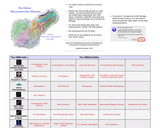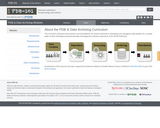
20 Results


This resource is a video abstract of a research paper created by Research Square on behalf of its authors. It provides a synopsis that's easy to understand, and can be used to introduce the topics it covers to students, researchers, and the general public. The video's transcript is also provided in full, with a portion provided below for preview:
"The non-receptor tyrosine kinase Abelson (Abl) is a key player in oncogenesis, causing diseases including chronic myelogenous and acute lymphoblastic leukemia. Drugs targeting Abl kinase activity serve as paradigms of targeted therapy. Drosophila is an ideal model for studying Abl’s function because there is only a single fly Abl family member. In flies, Abl is essential for embryonic morphogenesis, playing diverse roles in embryonic and adult viability. To examine the role of the intrinsically disordered region (IDR) of Abl, researchers deleted the IDR in Drosophila. They found that Abl lacking the IDR was not able to rescue the roles of Abl in viability and embryonic morphogenesis. The IDR was also essential for cell shape changes and cytoskeletal regulation during embryonic morphogenesis and, surprisingly, for modulating protein stability..."
The rest of the transcript, along with a link to the research itself, is available on the resource itself.
- Subject:
- Biology
- Life Science
- Material Type:
- Diagram/Illustration
- Reading
- Provider:
- Research Square
- Provider Set:
- Video Bytes
- Date Added:
- 10/16/2021

Students act as if they are biological engineers following the steps of the engineering design process to design and create protein models to replace the defective proteins in a child’s body. Jumping off from a basic understanding of DNA and its transcription and translation processes, students learn about the many different proteins types and what happens if protein mutations occur. Then they focus on structural, transport and defense proteins during three challenges posed by the R&D; bio-engineering hypothetical scenario. Using common classroom supplies such as paper, tape and craft sticks, student pairs design, sketch, build, test and improve their own protein models to meet specific functional requirements: to strengthen bones (collagen), to capture oxygen molecules (hemoglobin) and to capture bacteria (antibody). By designing and testing physical models to accomplish certain functional requirements, students come to understand the relationship between protein structure and function. They graph and analyze the class data, then share and compare results across all teams to determine which models were the most successful. Includes a quiz, three worksheets and a reference sheet.
- Subject:
- Biology
- Life Science
- Mathematics
- Measurement and Data
- Material Type:
- Activity/Lab
- Provider:
- TeachEngineering
- Provider Set:
- Activities
- Author:
- Beth Podoll
- Lauren Sako
- Date Added:
- 06/07/2018

This course examines the chemical and physical properties of the cell and its building blocks, with special emphasis on the structures of proteins and principles of catalysis, as well as the chemistry of organic / inorganic cofactors required for chemical transformations within the cell. Topics encompass the basic principles of metabolism and regulation in pathways, including glycolysis, gluconeogenesis, fatty acid synthesis / degradation, pentose phosphate pathway, Krebs cycle and oxidative phosphorylation.
Course Format
This OCW Scholar course, designed for independent study, is closely modeled on the course taught on the MIT campus. The on-campus course has two types of class sessions: Lectures and recitations. The lectures meet three times each week and recitations meet once a week. In recitations, an instructor or Teaching Assistant elaborates on concepts presented in lecture, working through new examples with student participation, and answers questions.
MIT students who take the corresponding residential class typically report an average of 10–15 hours spent each week, including lectures, recitations, readings, homework, and exams. All students are encouraged to supplement the textbooks and readings with their own research.
The Scholar course has three major learning units, called Modules. Each module has been divided into a sequence of lecture sessions that include:
Textbook Readings
Lecture Notes or Storyboards
A video by Professor JoAnne Stubbe or Professor John Essigmann
Problem Sets and solutions
To help guide your learning, each of these problem sets are accompanied by Problem Solving Videos where Dr. Bogdan Fedeles solves one of the problems from the set.
- Subject:
- Biology
- Life Science
- Material Type:
- Full Course
- Provider Set:
- MIT OpenCourseWare
- Author:
- Essigmann, John
- Fedeles, Bogdan
- Stubbe, Joanne
- Date Added:
- 09/01/2013

This course is an introduction to computational biology emphasizing the fundamentals of nucleic acid and protein sequence and structural analysis; it also includes an introduction to the analysis of complex biological systems. Topics covered in the course include principles and methods used for sequence alignment, motif finding, structural modeling, structure prediction and network modeling, as well as currently emerging research areas.
- Subject:
- Applied Science
- Biology
- Engineering
- Life Science
- Material Type:
- Full Course
- Provider Set:
- MIT OpenCourseWare
- Author:
- Burge, Christopher
- Fraenkel, Ernest
- Gifford, David
- Date Added:
- 02/01/2014

The MIT Biology Department core courses, 7.012, 7.013, and 7.014, all cover the same core material, which includes the fundamental principles of biochemistry, genetics, molecular biology, and cell biology. Biological function at the molecular level is particularly emphasized and covers the structure and regulation of genes, as well as, the structure and synthesis of proteins, how these molecules are integrated into cells, and how these cells are integrated into multicellular systems and organisms. In addition, each version of the subject has its own distinctive material.
7.012 focuses on the exploration of current research in cell biology, immunology, neurobiology, genomics, and molecular medicine.
Acknowledgments
The study materials, problem sets, and quiz materials used during Fall 2004 for 7.012 include contributions from past instructors, teaching assistants, and other members of the MIT Biology Department affiliated with course #7.012. Since the following works have evolved over a period of many years, no single source can be attributed.
- Subject:
- Biology
- Life Science
- Material Type:
- Full Course
- Provider Set:
- MIT OpenCourseWare
- Author:
- Chess, Andrew
- Gardel, Claudette
- Lander, Eric
- Weinberg, Robert
- Date Added:
- 09/01/2004

The MIT Biology Department core Introductory Biology courses, 7.012, 7.013, 7.014, 7.015, and 7.016 all cover the same core material, which includes the fundamental principles of biochemistry, genetics, molecular biology, and cell biology. The focus of 7.013 is on genomic approaches to human biology, including neuroscience, development, immunology, tissue repair and stem cells, tissue engineering, and infectious and inherited diseases, including cancer.
- Subject:
- Biology
- Life Science
- Material Type:
- Full Course
- Provider Set:
- MIT OpenCourseWare
- Author:
- Amon, Angelika
- Ray, Diviya
- Sive, Hazel
- Date Added:
- 02/01/2018

The MIT Biology Department core courses, 7.012, 7.013, and 7.014, all cover the same core material, which includes the fundamental principles of biochemistry, genetics, molecular biology, and cell biology. 7.013 focuses on the application of the fundamental principles toward an understanding of human biology. Topics include genetics, cell biology, molecular biology, disease (infectious agents, inherited diseases and cancer), developmental biology, neurobiology and evolution.
Biological function at the molecular level is particularly emphasized in all courses and covers the structure and regulation of genes, as well as, the structure and synthesis of proteins, how these molecules are integrated into cells, and how these cells are integrated into multicellular systems and organisms. In addition, each version of the subject has its own distinctive material.
- Subject:
- Biology
- Life Science
- Material Type:
- Full Course
- Provider Set:
- MIT OpenCourseWare
- Author:
- Jacks, Tyler
- Sinha, Diviya
- Sive, Hazel
- Date Added:
- 02/01/2013

The MIT Biology Department core courses, 7.012, 7.013, and 7.014, all cover the same core material, which includes the fundamental principles of biochemistry, genetics, molecular biology, and cell biology. Biological function at the molecular level is particularly emphasized and covers the structure and regulation of genes, as well as, the structure and synthesis of proteins, how these molecules are integrated into cells, and how these cells are integrated into multicellular systems and organisms. In addition, each version of the subject has its own distinctive material.
7.014 focuses on the application of these fundamental principles, toward an understanding of microorganisms as geochemical agents responsible for the evolution and renewal of the biosphere and of their role in human health and disease.
Acknowledgements
The study materials, problem sets, and quiz materials used during Spring 2005 for 7.014 include contributions from past instructors, teaching assistants, and other members of the MIT Biology Department affiliated with course 7.014. Since the following works have evolved over a period of many years, no single source can be attributed.
- Subject:
- Biology
- Life Science
- Material Type:
- Full Course
- Provider Set:
- MIT OpenCourseWare
- Author:
- Chisholm, Penny
- Khodor, Julia
- Mischke, Michelle
- Walker, Graham
- Date Added:
- 02/01/2005

Multi-scale systems (MuSS) consist of components from two or more length scales (nano, micro, meso, or macro-scales). In MuSS, the engineering modeling, design principles, and fabrication processes of the components are fundamentally different. The challenge is to make these components so they are conceptually and model-wise compatible with other-scale components with which they interface. This course covers the fundamental properties of scales, design theories, modeling methods and manufacturing issues which must be addressed in these systems. Examples of MuSS include precision instruments, nanomanipulators, fiber optics, micro/nano-photonics, nanorobotics, MEMS (piezoelectric driven manipulators and optics), X-Ray telescopes and carbon nano-tube assemblies. Students master the materials through problem sets and a project literature critique.
- Subject:
- Applied Science
- Engineering
- Material Type:
- Full Course
- Provider Set:
- MIT OpenCourseWare
- Author:
- Culpepper, Martin
- Kim, Sang-Gook
- Date Added:
- 09/01/2004

This resource is a video abstract of a research paper created by Research Square on behalf of its authors. It provides a synopsis that's easy to understand, and can be used to introduce the topics it covers to students, researchers, and the general public. The video's transcript is also provided in full, with a portion provided below for preview:
"Notch signaling is the key to many binary decisions metazoan cells make during development. Downstream signals from Notch trigger transcriptional remodeling that resolves dichotomies like differentiation between developmental cell fates. In the "Notch on" state, the Notch intracellular domain (NICD) relocates to the nucleus and binds to the protein RBPJ. While Notch activation is well studied, the transition to the "Notch off" state, where NICD and RBPJ dissociate, is not well understood. Recent research using phylogenetic analysis, computational biochemistry, and in vitro experiments suggests that heat flux is an important regulator of Notch signaling. The researchers determined that NICD senses temperature changes through its ankyrin domain. The ankyrin domain is highly conserved across species and contains β-hairpins enriched for charged amino acids. These charged amino acids amplify destabilizing electrostatic interactions, making the domain vulnerable to heat destruction..."
The rest of the transcript, along with a link to the research itself, is available on the resource itself.
- Subject:
- Biology
- Life Science
- Material Type:
- Diagram/Illustration
- Reading
- Provider:
- Research Square
- Provider Set:
- Video Bytes
- Date Added:
- 03/01/2023

The Online Macromolecular Museum (OMM) is a site for the display and study of macromolecules. Macromolecular structures, as discovered by crystallographic or NMR methods, are scientific objects in much the same sense as fossil bones or dried specimens: they can be archived, studied, and displayed in aesthetically pleasing, educational exhibits. Hence, a museum seems an appropriate designation for the collection of displays that we are assembling. The OMM's exhibits are interactive tutorials on individual molecules in which hypertextual explanations of important biochemical features are linked to illustrative renderings of the molecule at hand.
Why devote a site to detailed visualizations of different macromolecules? In learning about the intricacies of life processes at the molecular level, it is important to understand how natural selection has fashioned the structure and chemistry of macromolecular machines to suit them for particular functions. This understanding is greatly facilitated by the visualization of 3-dimensional structure, when known. So, if static views of molecules (even in stereo) are worth a thousand words, then interactive animations of molecules should be worth much more. Indeed, we have found the types of displays represented here invaluable in gaining an appreciation for the details of key biochemical processes.
As Carl Brandon and John Tooze stated in their classic text, Introduction to Protein Structure:
"Molecular biology began some 40 years ago with the realization that structure was crucial for a proper understanding of function. Paradoxically, the dazzling achievements of molecular genetics and biochemistry led to the eclipse of structural studies. We believe the wheel has now come full circle, and those very achievements have increased the need for structural analysis at the same time that they have provided the means for it."
It is our opinion that structural analysis should extend into the classroom: as students learn about cellular mechanisms it is important that they study the chemistry of the molecular machines involved. These considerations have motivated the construction of the OMM.
The OMM is part of a collaborative effort by faculty and students interested in macromolecular structure-function relationships. The primary authors of some tutorials are students of David Marcey and he serves as author, co-author and site editor, and assumes all responsibility for content. Any criticisms, suggestions, comments, or questions should be sent to him at: marcey@callutheran.edu. All tutorials are copyrighted.
The OMM was started in 1996 for a Molecular Biology class at Kenyon College, where DM was a professor in the Biology Department (1990-1999). The OMM is now developed and housed at California Lutheran University, where DM has been a professor since 1999.
- Subject:
- Chemistry
- Life Science
- Physical Science
- Material Type:
- Activity/Lab
- Diagram/Illustration
- Homework/Assignment
- Interactive
- Lesson
- Author:
- David Marcey
- Date Added:
- 09/28/2017

Primary, secondary, tertiary and quaternary protein structure. Beta pleated sheets and alpha helices.
- Subject:
- Biology
- Life Science
- Material Type:
- Lesson
- Provider:
- Khan Academy
- Provider Set:
- Khan Academy
- Author:
- Sal Khan
- Date Added:
- 07/17/2015

This curriculum introduces best practices recommendations for developing and managing a data pipeline for a curated public archive of biological experimental data, leveraging the extensive experience of the Research Collaboratory for Structural Bioinformatics Protein Data Bank (RCSB PDB) team. The curriculum has the following Learning Objectives:
Knowledge:
Identify the key stakeholders of a data archive and recognize their roles
Understand how to develop a data dictionary with the appropriate level of granularity
Recognize what is involved in designing and maintaining an archive for shared data
Skills:
Develop requirements for information to include in a data archive
Construct a deposition and annotation workflow based on a data dictionary
Design and implement a small deposition system for data capture
Provided exercises guide students step-by-step to design, create, and query their own biological MySQL-based database
Development of this resource was supported by National Institutes of Health National Library of Medicine R25LM012286 as part of the BD2K Initiative.
- Subject:
- Applied Science
- Computing and Information
- Life Science
- Material Type:
- Data Set
- Homework/Assignment
- Lecture
- Author:
- Brian Hudson
- Catherine L Lawson
- Ezra Peisach
- Helen M Berman
- Jasmine Young
- John Westbrook
- Jose Duarte
- Margaret Gabanyi
- Peter Rose
- Shuchismita Dutta
- Stephen Burley
- Date Added:
- 09/12/2018

This course provides a foundation in the following four areas: evolutionary and population genetics; comparative genomics; structural genomics and proteomics; and functional genomics and regulation.
- Subject:
- Biology
- Life Science
- Material Type:
- Full Course
- Provider Set:
- MIT OpenCourseWare
- Author:
- Berwick, Robert
- Kho, Alvin
- Kohane, Isaac
- Mirny, Leonid
- Date Added:
- 09/01/2005

This course provides an introduction to the physical chemistry of biological systems. Topics include: connection of macroscopic thermodynamic properties to microscopic molecular properties using statistical mechanics, chemical potentials, equilibrium states, binding cooperativity, behavior of macromolecules in solution and at interfaces, and solvation. Example problems include protein structure, genomic analysis, single molecule biomechanics, and biomaterials.
- Subject:
- Applied Science
- Biology
- Chemistry
- Engineering
- Life Science
- Physical Science
- Physics
- Material Type:
- Full Course
- Provider Set:
- MIT OpenCourseWare
- Author:
- Griffith, Linda
- Hamad-Schifferli, Kim
- Date Added:
- 02/01/2004

All cells, organs and tissues of a living organism are built of molecules. Some of them are small, made from only a few atoms. There is, however, a special class of molecules that make up and play critical roles in living cells. These molecules can consist of many thousands to millions of atoms. They are referred to as macromolecules (or large biomolecules).
- Subject:
- Biology
- Chemistry
- Life Science
- Mathematics
- Physical Science
- Physics
- Material Type:
- Activity/Lab
- Data Set
- Diagram/Illustration
- Interactive
- Provider:
- Concord Consortium
- Provider Set:
- Concord Consortium Collection
- Author:
- National Science Foundation
- The Concord Consortium
- Date Added:
- 08/18/2011

This resource is a video abstract of a research paper created by Research Square on behalf of its authors. It provides a synopsis that's easy to understand, and can be used to introduce the topics it covers to students, researchers, and the general public. The video's transcript is also provided in full, with a portion provided below for preview:
"The microscopic tardigrade is one of the toughest known organisms in the animal kingdom, capable of surviving environmental extremes such as near-complete desiccation, freezing and high temperatures, and ionizing radiation. Exactly how these tiny creatures are able to withstand these stresses has remained largely a mystery. Now, research is showcasing the role of three protein families not found in other organisms, collectively referred to as tardigrade disordered proteins (TDPs). Unlike typical folded proteins, in solution many TDPs lack a stable 3D structure. This lack of structure may allow them to adopt different conformations under different environmental conditions. Although seemingly diverse, the stress conditions that tardigrades can tolerate are actually quite similar. Similarly to desiccation, freezing removes water from proteins and membranes, and irradiation induces genome damage like that observed during drying..."
The rest of the transcript, along with a link to the research itself, is available on the resource itself.
- Subject:
- Biology
- Life Science
- Material Type:
- Diagram/Illustration
- Reading
- Provider:
- Research Square
- Provider Set:
- Video Bytes
- Date Added:
- 11/13/2020

This resource is a video abstract of a research paper created by Research Square on behalf of its authors. It provides a synopsis that's easy to understand, and can be used to introduce the topics it covers to students, researchers, and the general public. The video's transcript is also provided in full, with a portion provided below for preview:
"Of the 20 standard amino acids, 18 can be coded by two to six synonymous codons. The preference for certain synonymous codons over others is a phenomenon known as “codon usage bias,” and it's been found in all genomes examined to date. Growing evidence suggests that codon usage regulates protein structure and gene expression through translation-dependent and translation-independent mechanisms. In fact, codon usage has been discovered to play an important role in controlling the speed of translation elongation during mRNA translation, as well as in regulating protein folding and function in both prokaryotes and eukaryotes. Additionally, studies show that intrinsically disordered domain structures are sensitive to codon usage. These disordered structures play a critical role in many biological processes and are sites for important post-translational modifications..."
The rest of the transcript, along with a link to the research itself, is available on the resource itself.
- Subject:
- Biology
- Life Science
- Material Type:
- Diagram/Illustration
- Reading
- Provider Set:
- Video Bytes
- Date Added:
- 11/12/2020

This resource is a video abstract of a research paper created by Research Square on behalf of its authors. It provides a synopsis that's easy to understand, and can be used to introduce the topics it covers to students, researchers, and the general public. The video's transcript is also provided in full, with a portion provided below for preview:
"Chloroplast protein of 12 kDa (CP12) participates in the Calvin Benson Bassham (CBB) cycle and many other processes in higher plants, microalgae, and cyanobacteria. The CP12-encoding gene is conserved in many diatoms, but CBB cycle regulation differs between diatoms and other photosynthetic organisms, and CP12 has not been characterized in these ecologically important and evolutionarily complex microalgae. A recent study addressed this knowledge gap by characterizing CP12 in the marine diatom Thalassiosira pseudonana. Using a variety of techniques, researchers found that this CP12 is expressed under both light and dark conditions and throughout growth and that it exhibits some features of intrinsically disordered proteins, like CP12 proteins in other organisms. The protein is an elongated cylinder with kinks and numerous unstable dynamic α-helices. In addition, it exists as a dimer, in contrast to previously characterized monomeric CP12s..."
The rest of the transcript, along with a link to the research itself, is available on the resource itself.
- Subject:
- Biology
- Life Science
- Material Type:
- Diagram/Illustration
- Reading
- Provider:
- Research Square
- Provider Set:
- Video Bytes
- Date Added:
- 10/14/2021